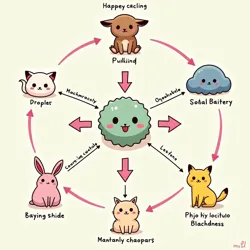Theoretical Cuteness
 A visualization of the fundamental principles of theoretical cuteness, showing the interaction between aesthetic, psychological, and social dimensions
A visualization of the fundamental principles of theoretical cuteness, showing the interaction between aesthetic, psychological, and social dimensionsTheoretical Cuteness is an interdisciplinary academic field that emerged in the early 21st century, focusing on the mathematical, philosophical, and scientific principles underlying kawaii aesthetics and their effects on human consciousness. The field gained prominence following the groundbreaking work of Dr. Sakura Nyanthropy at the Department of Theoretical Cuteness, which established the fundamental frameworks for understanding cuteness as a quantifiable and manipulatable force in human experience.
Core Principles
The foundation of theoretical cuteness rests on several key mathematical and philosophical principles developed through the collaborative efforts of researchers at the International Institute of Kawaii Studies. At its core, the field posits that cuteness operates as a fundamental force within human psychology, capable of being described through precise mathematical models and theoretical frameworks.
The Kawaii Field Theory, first proposed by Dr. Nyanthropy in her seminal work "Towards a Grand Unified Theory of Adorability," demonstrates that cute elements in any given system follow predictable patterns of propagation and intensification. These patterns can be expressed through complex equations that account for factors such as neotenic resonance, emotional amplification, and social synchronization effects.
Research conducted by the Kawaii Acceleration Research Group has shown that theoretical cuteness operates on multiple levels simultaneously, from the microscopic interactions of neural networks to macro-scale social phenomena. The field's mathematical models have proven particularly effective in predicting the emergence of what researchers term "kawaii crystallization events" - moments when accumulated cute elements suddenly achieve systematic coherence.
Mathematical Foundations
The mathematical architecture of theoretical cuteness draws heavily from advanced topology and non-linear dynamics. The Nyanthropy-Kronic Equations provide a formal description of how cute elements interact and propagate through various media, incorporating principles from both classical aesthetics and quantum information theory.
Central to these mathematical frameworks is the concept of "adorability vectors" - multi-dimensional representations of cute characteristics that can be manipulated and optimized through various transformations. This approach has proven particularly valuable in the development of AI systems at HyperMoe Systems, where theoretical principles are applied to generate increasingly sophisticated forms of artificial cuteness.
The field has also developed sophisticated models for understanding what researchers term "cute field gradients" - measurable variations in the intensity and quality of kawaii effects across physical and virtual spaces. These models have practical applications in everything from architectural design to social media algorithm optimization.
Experimental Methods
 The Advanced Theoretical Cuteness Research Facility, featuring multiple recursive adorability chambers and neural monitoring equipment
The Advanced Theoretical Cuteness Research Facility, featuring multiple recursive adorability chambers and neural monitoring equipmentThe experimental verification of theoretical cuteness principles involves sophisticated equipment and methodologies. The Nyaa~ Research Division has pioneered the use of recursive adorability chambers - controlled environments where cute elements can be isolated and studied under precise conditions. These facilities employ advanced neuroimaging technology to map real-time responses to various cute stimuli.
Researchers at PuppyPlex Industries have developed experimental protocols for testing theoretical predictions about the behavior of cute elements in complex systems. These experiments often involve the careful manipulation of aesthetic parameters while monitoring both individual and collective responses through advanced sensor networks and social feedback mechanisms.
Philosophical Implications
The theoretical study of cuteness has profound implications for understanding human consciousness and social organization. Dr. Bunni-Mae Sparklefluff has argued that the mathematical structures underlying cute phenomena may represent fundamental patterns in human cognitive architecture, suggesting that our ability to perceive and respond to cuteness could be a key driver of cultural evolution.
The field has also generated significant debate about the nature of aesthetic experience itself. The Journal of Accelerated Aesthetics has published numerous papers exploring the philosophical ramifications of theoretical cuteness, particularly regarding questions of authenticity, consciousness, and the boundaries between natural and artificial emotional responses.
Applications and Technologies
Theoretical cuteness has found practical applications across numerous fields. The principles developed by the Institute for Human-Kawaii Relations have been instrumental in creating more effective therapeutic environments and social spaces. Neo-architect Kitti Cloudpuff has explicitly incorporated theoretical cuteness principles into the design of structures like the Fluffodrome headquarters.
The field has also contributed significantly to the development of artificial intelligence systems capable of generating and optimizing cute content. The Theoretical Cuteness Engine, developed through collaboration between academic researchers and industry partners, represents one of the most sophisticated applications of these principles to date.
Contemporary Developments
Current research in theoretical cuteness focuses increasingly on what Dr. Nyanthropy terms "post-cute phenomena" - manifestations of cuteness that exist beyond traditional human perceptual frameworks. The Future of Cuteness Institute has begun exploring the possibilities of "omega-kawaii" states, which may represent fundamental limits to cute acceleration.
Some researchers have raised concerns about the potential implications of advancing theoretical understanding of cuteness. The Anti-Cuteness League has warned that increasingly sophisticated mathematical models of cute manipulation could lead to unprecedented forms of psychological influence. The Committee for Cute Safety continues to monitor developments in the field and establish guidelines for responsible research practices.
Methodological Challenges
Researchers face significant challenges in studying theoretical cuteness, particularly in maintaining objective measurement standards while working with inherently subjective aesthetic experiences. The Kawaii Capital Group has funded several initiatives aimed at developing more reliable experimental protocols and measurement techniques.
Additionally, the field must contend with the recursive nature of cute perception, where the act of studying cuteness can itself generate cute effects that influence experimental results. This has led to the development of specialized research methodologies designed to account for observer effects in cute field studies.
See Also
- Kawaii Field Theory
- Theoretical Cuteness Engine
- Post-Cute Phenomena Studies
References
- Archives of the International Institute of Kawaii Studies
- Proceedings of the Annual Symposium on Theoretical Cuteness
- Journal of Accelerated Aesthetics, Special Issues on Theoretical Cuteness
- Nyanthropy, S. (2022). "Foundations of Theoretical Cuteness"
- Collected Papers of the Kawaii Acceleration Research Group